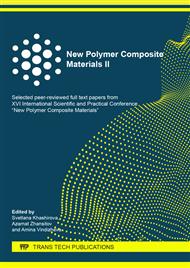p.315
p.321
p.336
p.342
p.348
p.357
p.362
p.367
p.375
The Effect of Inorganic Fillers on the Polyaniline Synthesis
Abstract:
The kinetics of the synthesis of polyaniline in the presence of inorganic fillers was studied. It is shown that the acid-base surface properties of the inorganic filler affect the polymerization time. The introduction of a filler in the reaction mass containing aniline leads to a decrease in the induction period of oxidative polymerization. The decrease in the induction period is due to the fact that aniline is adsorbed on the surface of the filler. This leads to the fact that polyaniline is formed as a thin layer on the surface of the carrier. With a further increase in the content of inorganic filler, the time of the induction period increases. This is due to the fact that the surface of talc has a basic character. The use of mica as an inorganic filler leads to a decrease in the induction period of polymerization in the entire range of the carrier content studied.
Info:
Periodical:
Pages:
348-356
Citation:
Online since:
October 2020
Price:
Сopyright:
© 2020 Trans Tech Publications Ltd. All Rights Reserved
Share:
Citation:


